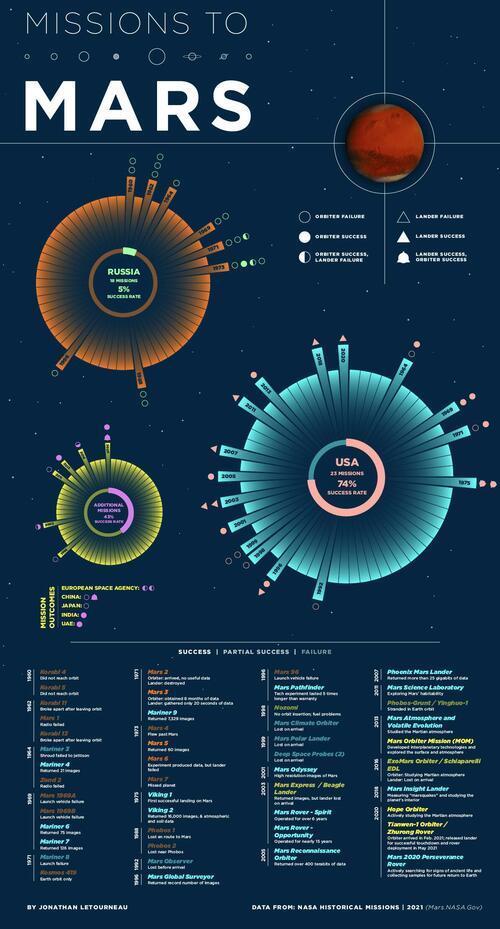
Within our Solar System, Mars is one of the most similar planets to Earth—both have rocky landscapes, solid outer crusts, and cores made of molten rock.
Because of its similarities to Earth and proximity, humanity has been fascinated by Mars for centuries. In fact, it’s one of the most explored objects in our Solar System.
But just how many missions to Mars have we embarked on, and which of these journeys have been successful? This graphic by Jonathan Letourneau shows a timeline of every mission to Mars since 1960 using NASA’s historical data.
A Timeline of Mars Explorations
According to a historical log from NASA, there have been 48 missions to Mars over the last 60 years. Here’s a breakdown of each mission, and whether or not they were successful:
The first mission to Mars was attempted by the Soviets in 1960, with the launch of Korabl 4, also known as Mars 1960A.
As the table above shows, the voyage was unsuccessful. The spacecraft made it 120 km into the air, but its third-stage pumps didn’t generate enough momentum for it to stay in Earth’s orbit.
For the next few years, several more unsuccessful Mars missions were attempted by the USSR and then NASA. Then, in 1964, history was made when NASA launched the Mariner 4 and completed the first-ever successful trip to Mars.
The Mariner 4 didn’t actually land on the planet, but the spacecraft flew by Mars and was able to capture photos, which gave us an up-close glimpse at the planet’s rocky surface.
Then on July 20, 1976, NASA made history again when its spacecraft called Viking 1 touched down on Mars’ surface, making it the first space agency to complete a successful Mars landing. Viking 1 captured panoramic images of the planet’s terrain, and also enabled scientists to monitor the planet’s weather.
Vacation to Mars, Anyone?
To date, all Mars landings have been done without crews, but NASA is planning to send humans to Mars by the late 2030s.
And it’s not just government agencies that are planning missions to Mars—a number of private companies are getting involved, too. Elon Musk’s aerospace company SpaceX has a long-term plan to build an entire city on Mars.
Two other aerospace startups, Impulse and Relativity, also announced an unmanned joint mission to Mars in July 2022, with hopes it could be ready as soon as 2024.
As more players are added to the mix, the pressure is on to be the first company or agency to truly make it to Mars. If (or when) we reach that point, what’s next is anyone’s guess.
Within our Solar System, Mars is one of the most similar planets to Earth—both have rocky landscapes, solid outer crusts, and cores made of molten rock.
Because of its similarities to Earth and proximity, humanity has been fascinated by Mars for centuries. In fact, it’s one of the most explored objects in our Solar System.
But just how many missions to Mars have we embarked on, and which of these journeys have been successful? This graphic by Jonathan Letourneau shows a timeline of every mission to Mars since 1960 using NASA’s historical data.
A Timeline of Mars Explorations
According to a historical log from NASA, there have been 48 missions to Mars over the last 60 years. Here’s a breakdown of each mission, and whether or not they were successful:
The first mission to Mars was attempted by the Soviets in 1960, with the launch of Korabl 4, also known as Mars 1960A.
As the table above shows, the voyage was unsuccessful. The spacecraft made it 120 km into the air, but its third-stage pumps didn’t generate enough momentum for it to stay in Earth’s orbit.
For the next few years, several more unsuccessful Mars missions were attempted by the USSR and then NASA. Then, in 1964, history was made when NASA launched the Mariner 4 and completed the first-ever successful trip to Mars.
The Mariner 4 didn’t actually land on the planet, but the spacecraft flew by Mars and was able to capture photos, which gave us an up-close glimpse at the planet’s rocky surface.
Then on July 20, 1976, NASA made history again when its spacecraft called Viking 1 touched down on Mars’ surface, making it the first space agency to complete a successful Mars landing. Viking 1 captured panoramic images of the planet’s terrain, and also enabled scientists to monitor the planet’s weather.
Vacation to Mars, Anyone?
To date, all Mars landings have been done without crews, but NASA is planning to send humans to Mars by the late 2030s.
And it’s not just government agencies that are planning missions to Mars—a number of private companies are getting involved, too. Elon Musk’s aerospace company SpaceX has a long-term plan to build an entire city on Mars.
Two other aerospace startups, Impulse and Relativity, also announced an unmanned joint mission to Mars in July 2022, with hopes it could be ready as soon as 2024.
As more players are added to the mix, the pressure is on to be the first company or agency to truly make it to Mars. If (or when) we reach that point, what’s next is anyone’s guess.






